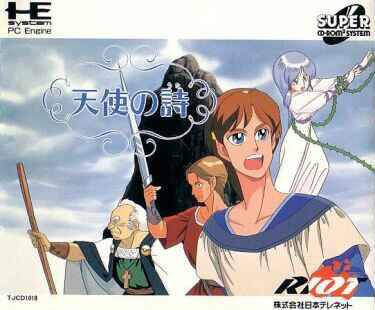
I just finished Tenshi no Uta, and like I did with Gulliver Boy, I'd like to share what I thought about it.
It was good. Very good, actually, especially for a 1991 RPG.
Before anything else, some quick facts:
- There's no timer, but I'm guessing it's around a 20 hour game.
- Fighting is done in a Dragon Quest-style turn-based battle engine, with random encounters.
-You learn magic as you level up. No skills are bought or taught.
- You buy equipment and find it in treasure chests in the usual way. You have five equipment slots: for your right hand, left hand, head, body, and for an extra thing.
- Item inventories are separated by character, and are very limited in capacity.
- Your party grows to five members, although you spend a lot of time with only four. Those five are the only five you play as in the game.
- You don't gain a whole lot of levels. You'll probably beat the game around level 40.
- There are maybe six or seven cutscenes total.
- The music is all redbook except for what you hear in battles and in shops.
- It's highly linear, and also generally easy.
So, why did I like this one? Tenshi no Uta has some flaws, and I'll tell you about them soon, but basically I enjoyed this game so much that not only would I recommend it, but I would also like to translate it someday.
Tenshi no Uta's first key asset is its pacing, which it owes in part to its linearity. Compared to other RPGs anyway, you're never going to be stuck in one place for long while playing this game, and you're almost never going to backtrack, either. It's simply a very pleasant, brisk adventure, with a healthy amount of variety and just the right amount of length given its scope. There will be no frustration from not knowing where to go or how to trigger the right conditions to make the story advance. There's also no despair from overly complex or difficult dungeons. Put in 20 minutes, and you are virtually guaranteed to accomplish a significant objective and go somewhere new.
Another great thing about Tenshi no Uta is the cohesiveness in its art style and layout design. What this accomplishes is to give you is a feeling for the world of the game itself. Although the story doesn't build up in a particularly grand way, you will feel like you've truly completed a journey right alongside the characters as you come to the end of the game.
The music and graphics are good, especially for 1991. There is certainly some asset recycling, yes, but this is spaced out sensibly, and the game is generally rich enough that you won't care much. One thing I really like is the water effects. There must be two dozen different styles of animating water tiles in this game, and they all look great.
The story is simple, and admittedly fairly typical. The characters could be described in the same way. However, I don't think that that's really what this game is about. The focus is much more on the dungeons, each of which is unique, and on hopping across the continents one after another. The story serves this, not the other way around, and in that regard, it's perfectly adequate.
So, let's hit the bad points:
- The character-specific, limited inventory system is a pain. You'll have to spend a few minutes shuffling things around every time you get a few new items. Also, shops don't tell you anything about the stats of the weapons and armor they sell, and the equip screen itself only tells you about changes to a couple of stats rather than all of them. It's hard to explain, but you basically need a table explaining all the items in order to deal with it in any kind of efficient way.
- There is some long, forced grinding at the end. The last major continent is packed with killer enemies, and the last boss is a bastard. You'll need both high levels and expensive equipment.
- Like many CD RPGs, this one could really use some more music. Again, they used and recycled what they had in a very sensible way, but more tracks would have been very welcome.
- The battles in the first 80% of the game are easy enough that you can often turn on auto-fire and space out/check your email/whatever.
- The art style in the cutscenes is honestly quite unattractive.
- The random encounter rate isn't really all that high, but lowering it slightly would have made thoroughly exploring the dungeons much more appealing. This is important, because some great equipment is hidden in dungeons.
- There are bugs. As a matter of fact, one bug freezes the game. It happens occasionally when you walk through doors that cause the tile layer to change without any fadeout. I had probably four or five freezes during my playthrough. Fortunately, they mostly happen in towns, where you can save your game.
- The NPC dialog gets better as the game goes on, but in the early parts especially there's a fairly high number of townspeople who seem to be repeating each others lines about whatever is that's bothering their specific town.
...So, yeah, far from perfect. Yet in spite of these things, Tenshi no Uta 1 is still a solid and downright charming RPG.
The guide over on the Duomazov site does an excellent job of helping you through the story, and
this Japanese guide can fill you in on the details for all of the items.
I am going to play part two next. I can already see that they fixed a couple of things I didn't like about part one, so I'm excited to see how it goes!